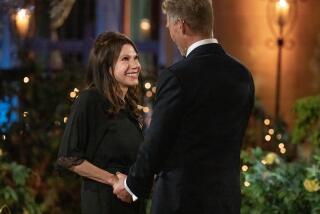They said it couldn’t be done
ESPN redefined sports broadcasting in 1979 by offering a smorgasbord of programming. But entrepreneur Joseph E. Gibbs and golf legend Arnold Palmer subsequently proved that some fans have an appetite for a channel that serves up only a single sport 24/7.
Since the Golf Channel went live in January 1995 with a tournament broadcast from Dubai, it has focused on preliminary rounds of PGA tournaments, seniors golf, the LPGA and overseas events, along with a healthy portion of how-to shows and interviews. And, of course, the intoxicating -- at least to golfers -- infomercials touting such got-to-have training devices as shaft-weighted swing trainers, dual-hinged drivers and the revolutionary Stance Minder.
Gibbs persuaded Palmer -- the two met when the golfer was playing on a course where Gibbs lived -- to become an early investor in the Golf Channel. Together, they secured the support of several large cable television companies. But the venture still had a rough go -- it burned through $135 million in four years before breaking even.
The Golf Channel now reaches 70 million U.S. homes, or about 20 million fewer than sports giant ESPN. Its revenue from advertising and cable operator fees hit $101 million in 2005, making it the biggest single-sport cable channel, according to Kagan Research LLC. That dwarfs such rivals as Speed Channel and Tennis Channel, but noticeably lags ESPN ($966.5 million in revenue) and traditional broadcast networks.
Media analysts estimate the value of the channel, now owned by Comcast Corp., at about $1 billion.
“Give credit to Golf Channel,” said longtime cable industry consultant Stephen R. Effros. “They saw the potential a lot earlier than other people did and they’ve capitalized on it very well. A lot of other entrepreneurs and the sports leagues themselves are now trying to emulate them.”
To broaden its viewership, the channel now screens such fare as “Caddyshack” and a reality TV show that lets viewers catch LPGA golfer Natalie Gulbis at her annual swimsuit calendar shoot. Its “Big Break” series -- part “Survivor,” part Skins Game -- pits nine male and nine female golfers against one another for the opportunity to play in a pro tournament. And, early next year the channel will invite duffers-turned-inventors to compete in a reality TV show that promises to determine “golf’s next great training aid.”
The bulk of the Golf Channel’s programming continues to target hard-core fans. In January the channel will become the PGA Tour’s exclusive cable partner -- which means no more dashing from the Golf Channel to ESPN to the USA Network to determine which channel is carrying the early rounds of the weekend’s PGA tournament.
Most of the Saturday and Sunday PGA action -- and golf’s four major events -- will continue on the big networks and their cable partners, but the 15-year deal gives the Golf Channel exclusive TV rights to a dozen lesser tournaments, including the Sony Open in Hawaii in January.
The channel also has broadcast rights to some LPGA events, which gives its cameras access to players such as Annika Sorenstam and Michelle Wie. It also has about 30 commentators and analysts, who cover tournaments, including Nick Faldo.
Gibbs resigned as the Golf Channel’s chief executive in 2001 to start a venture capital firm, and Palmer sold out his stake years ago, but their programming blueprint remains. Thursday through Sunday, the channel focuses on tournament action; the rest of the week is spent looking back or previewing the next event.
Gibbs’ pitch at the outset was relatively simple. No one expected golfers to tune in around the clock, but, given the opportunity, he believed that dedicated golfers would search out the channel when they had time. He also was betting that advertisers would be drawn to a channel that reflected golf’s upscale demographic.
Palmer was an important business partner, Gibbs said, one who could open doors and use his wealth of golf and business savvy to persuade cable executives, advertisers and IMG founder and sports marketing guru Mark McCormack to support the channel.
“It took three years of me living on the road five days week, making four or five pitches a day to convince people that this would work,” Gibbs said. “Ultimately, we got enough support that we did have the Palmers, McCormacks and the PGA Tour come on board. But it happened piece by piece.”
When Gibbs began soliciting investors, one future partner scratched his head upon receiving a nondisclosure agreement Gibbs mailed from his office in Birmingham, Ala. Cable TV veteran George Greenberg, who brought the Sci Fi Channel into life, worked for a while with Gibbs and now runs the HorseTV Channel, joked that, upon seeing the postmark from deep in the heart of the Bible Belt and the unknown TGC logo, “I figured that it’s got to be The God Channel.”
Today, 75% of the Golf Channel’s viewers are males and the median age of its viewers is 51, with a median household income of nearly $80,000. Current Chief Executive David Manuogian says the channel is the wrong place to sell laundry detergent, but a great vehicle for marketing upscale automobiles, pricey golf clubs or financial services.
The Golf Channel’s success spawned a number of imitators, but the economics of cable television, along with the rush of new technologies offering sports and entertainment, are making that pursuit tougher.
The biggest hurdle today is the unwillingness of cable operators to turn over more space to new sports channels. Newcomers are likely to end up on higher-cost digital tiers or satellite services.
But that hasn’t stopped programmers from trying to copy Gibbs’ success.
“I saw the Golf Channel and thought, ‘How are they getting a channel when tennis isn’t?’ ” recalled Tennis Channel founder Steve Bellamy, who in May left the channel to concentrate on other sports-related business interests. “That’s when wheels started to turn in my head.”
Success for sports-specific channels is determined largely by how well they manage the task of paying big sums for broadcast rights while struggling to build revenue from cable company fees and advertising. Industry analysts predict the Golf Channel will get a double-digit bump in ratings next year because it will be easier for viewers to find PGA action.
Although the deals help establish a channel’s brand awareness, they can be expensive. Kagan Research, estimates that it will take six years for the Tennis Channel to break even.
*
(BEGIN TEXT OF INFOBOX)
Cable cash
ESPN’s channels still dominate cable sports, but sports-specific channels are “storming the high ground,” according to Monterey, Calif.-based Kagan Research, LLC. The top 10 channels in 2005 ranked by gross advertising revenue and year launched:
*--* Rank Name GAR (mill.) Year 1. ESPN $966.5 1979 2. ESPN2 $192.6 1993 3. FSN $123.5 1996 4. Golf Channel $101.7 1995 5. Speed Channel $84.8 1996 6. ESPN Classic $63.3 1995 7. Versus* $52.9 1995 8. ESPN News $49.6 1996 9. Fox Soccer Net $36.0 1997 10. Outdoor Channel $26.0 1993
*--*
* formerly OLN. GAR: gross advertising revenue
Source: Kagan Research LLC
More to Read
The biggest entertainment stories
Get our big stories about Hollywood, film, television, music, arts, culture and more right in your inbox as soon as they publish.
You may occasionally receive promotional content from the Los Angeles Times.






